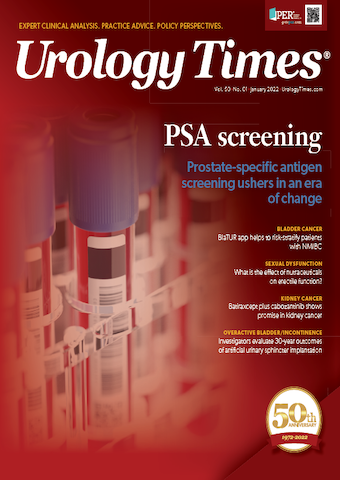Publication
Article
Urology Times Journal
30-year outcomes of retrospective artificial urinary sphincter study
Author(s):
Investigators reported 30-year outcomes of artificial urinary sphincter (AUS) implantation in male patients with non-neurogenic incontinence at the 2021 International Continence Society Annual Meeting.1
Elodie Beels, MD

“The artificial urinary sphincter has been used since 1972 and has proven to be a reliable clinical option for male non-neurogenic incontinence, but robust scientific data about its exact efficacy, complication profile, and long-term patient satisfaction rates are still lacking,” said presenting presenter Elodie Beels, MD, a urologist at University Hospital in Leuven, Belgium.
To resolve this data absence, Beels and co-authors sought to examine implant survival and revision-free survival of Boston Scientific’s AMS 800 AUS implant through a retrospective study of outcomes at a tertiary center. Other goals of this study were to assess long-term functional outcomes, patient satisfaction, and potential risk factors for failure. All implants were performed by 2 experienced surgeons and all patients had AUS implanted for non-neurogenic stress urinary incontinence (both primary and secondary were included).
Over the course of 30 years (June 1989 – January 2020), 263 patients were implanted with AUS via a perineal approach with a bulbar cuff and 61-70cmH20 reservoir followed by the deactivation of the sphincter. Patients were then given antibiotic prophylaxis and a follow-up was performed after 6 weeks to activate the device. An additional office evaluation was performed after 2 to 3 months, but after that, follow-up was on an as-needed basis.
To analyze patient characteristics, perioperative data, complication and revision rate, patients completed Patient Global Impression of Improvement (PGI-I) and telephone questionnaires at the end of this study. Logistic regression models were also used to determine the risk factors revision surgery, persistence, recurrence of incontinence, and patient dissatisfaction.
“The median patient age was 69 years and 86.7% of the patients became incontinent due to radical prostatectomy. 83.4% of patients had comorbidities, including prior pelvic irradiation, diabetes, anticoagulation therapy, previous surgery for incontinence, or treatment for stricture disease,” reported Beels.
In the population of 263 patients, 294 sphincters were implanted. 249 of those patients received 1 implant, 40 of those patients received a second implant, and 5 of those patients received a third. Of note, 71 (24.2%) of these implants were explanted again, mainly due to urethral erosion (50%) or infection (40%). The 5-year results found that 75.3% were still in situ and the median time to explant was 16.2 years.
More outcomes showed that 73 patients (24.8%) underwent revision or maintenance surgery. At 5 years, the overall revision-free implant survival rate was 62.10% and at 10 years it was 49.43%. The median revision-free implant survival rate was 10 years.
While anticoagulation therapy, previous AUS implants, and treatment for urethral stricture disease were all significant risk factors for explant, “Controversy remains regarding the impact of previous pelvic radiation. In our cohort, almost half of the patients received prior pelvic radiotherapy, which is a very high proportion of patients compared to other similar studies,” said Beels. “In univariate analysis…prior pelvic radiation therapy was a risk factor for AUS explant and not achieving social continence, although it must be noted that patients with prior radiation therapy are often more comorbid, which may also influence AUS survival and outcomes rates.”
Overall, 35.9% of patients who underwent anticoagulation therapy were at a higher risk for AUS explant (HR, 1.7; P = .04) and this therapy also proved to be an independent risk factor for social incontinence (HR, 0.6; P <.01) and patient satisfaction (HR, 3.9; P = .03).
“To our knowledge, no other previous studies report this association, although its exact underlying mechanism remains elusive,” said Beels.
Additional results showed that 60.3% of patients implanted with AUS demonstrated social continence (needing ≤1 pad/day) after 5 years and 37.9% demonstrated social continence after 10 years. The median time to becoming socially incontinent was 7 years.
In April 2020, 142 patients (54% of total population) completed QOL and incontinence questionnaires. The 52% socially dry rate for this population was similar to that of the overall population (51.4%), and at 5 years, the patient satisfaction rate was 97.9%. At 10 years, the patient satisfaction rate was 87.5%. Those who had higher bladder capacity (HR, 0.6; P = .02) as well as those who were completely incontinent prior to AUS implantation (HR, 0.1; P = .02) were associated with higher rates of satisfaction.
In their concluding remarks, Beels said, “In this large caseload series with extended follow-up and specific focus on long-term functional outcomes and patient satisfaction, a significant proportion of AUS implants needed revision or explant surgery. Long-term continence rates are acceptable but tend to decrease by time. Nonetheless, if patients can maintain a functional AUS in-situ, long-term patient satisfaction rates remain high. AUS patients should be appropriately counselled in light of these findings.”
Reference
1. Schillebeeckx C, Deruyver Y, Beels E, et al. Long-term functional outcomes and patient satisfaction of artificial urinary sphincter implantation for male non-neurogenic incontinence: a retrospective study of 30-year experience in a tertiary centre. Paper presented at: 2021 International Continence Society Annual Meeting; October 14-17, 2021. Abstract 4.

Newsletter
Stay current with the latest urology news and practice-changing insights — sign up now for the essential updates every urologist needs.































